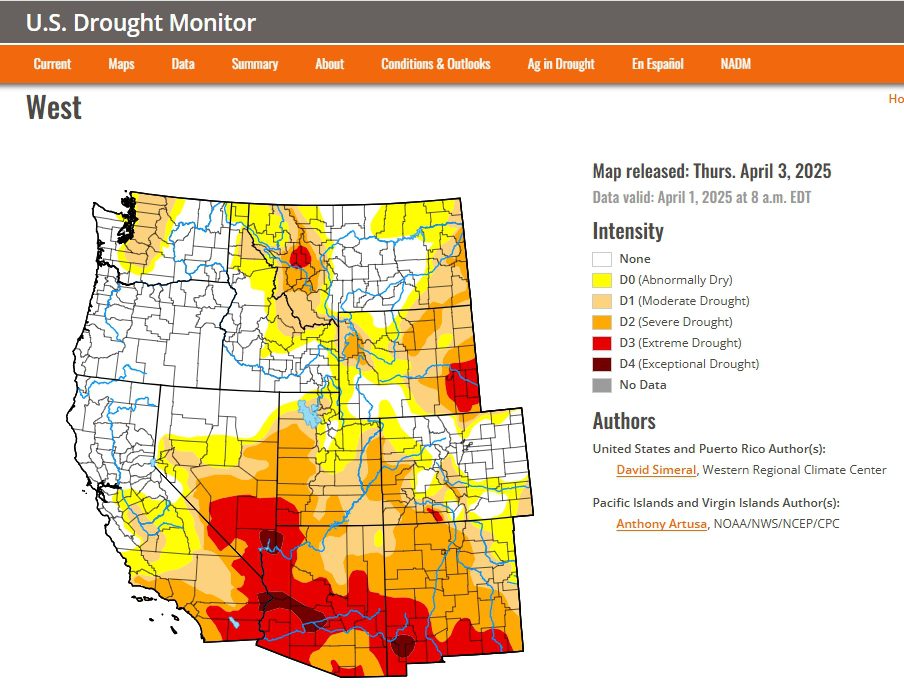- Arizona and Colorado see intensifying drought in key watersheds.
- Snowpack in the Lower Colorado and Rio Grande is far below normal.
- Lake Powell and Lake Mead remain critically low.
Saturday, April 5, 2025 — After weeks of varied precipitation across the United States, the April 3, 2025 U.S. Drought Monitor reveals a mixed picture of improvement and degradation—but the outlook in the Colorado River Basin states is largely concerning. While recent Pacific storms brought needed relief to parts of the West, critical reservoirs and snowpacks in the Southwest continue to show signs of strain.
reveals a mixed picture of improvement and degradation—but the outlook in the Colorado River Basin states is largely concerning. While recent Pacific storms brought needed relief to parts of the West, critical reservoirs and snowpacks in the Southwest continue to show signs of strain.
Southwest Sees Expanding Dryness.
“Drought expanded and intensified across areas of southeastern and northeastern Arizona, northeastern New Mexico, and southwestern Colorado,” according to the report , which cited below-normal snowpack and poor streamflow as major factors.
, which cited below-normal snowpack and poor streamflow as major factors.
In Arizona, areas under Extreme Drought (D3) have grown in both the northeastern and southeastern regions. As of April 1, the snow water equivalent (SWE) in the Lower Colorado region was just 49% of normal, while the Rio Grande region mirrored the same low percentage. Northern New Mexico and southern Utah are also suffering from “poor snowpack conditions,” contributing to increased drought severity.
Reservoir levels in Arizona reinforce the concern. The Salt River system is currently 72% full and the Verde River system sits at 53% full, for a total combined reservoir system at 70% of capacity. This is a steep drop from the 89% total just one year ago.
Colorado’s Snow Deficit Raises Alarms.
Across Colorado, particularly in the southwest, snowpack conditions remain well below average in the San Juan and Sangre de Cristo ranges. These basins are vital sources of runoff for the Colorado River. The Upper Colorado region snowpack sits at 89% of normal as of April 1, while the Lower Colorado lags at 49%.
In terms of reservoir storage, Lake Powell is at just 32% full—amounting to 55% of its typical level for this time of year. Lake Mead fares slightly better at 34% full, or 54% of average. Together, the total Lower Colorado system stands at 41% capacity, which is barely changed from 42% at this time last year, according to the U.S. Bureau of Reclamation.
Other Basin States: Mixed Conditions.
-
Nevada and Utah received a modest lift from the recent storms. Northern Utah saw snowfall accumulations between 6 and 24 inches in the Wasatch and Uinta ranges.
-
Wyoming and New Mexico, on the other hand, continue to face drier-than-normal conditions in many basins. New Mexico’s largest reservoir on the Rio Grande is just 14% full—only 30% of its historical average.
-
California fared better. The state’s two largest reservoirs, Shasta and Oroville, were at 113% and 121% of average, respectively. The statewide snowpack reached 96% of normal by April 1.
-
Arizona stands out as the most impacted. The state has experienced significant drought degradation over the past month, supported by a 19-point rise in the Drought Severity and Coverage Index (DSCI) since the start of the Water Year.
What the Data Shows.
According to the latest dataset, the overall U.S. drought picture saw modest change in the past week, but regional shifts are telling:
| Week | D0-D4 | D1-D4 | D2-D4 | D3-D4 | D4 |
|---|---|---|---|---|---|
| April 1, 2025 (Current) | 64.96 | 48.56 | 31.29 | 13.27 | 1.21 |
| March 25, 2025 | 65.23 | 49.06 | 29.85 | 13.30 | 1.21 |
While national drought levels changed only slightly, the Southwest’s conditions are worsening in key regions that impact the entire Colorado River system.
Final Word.
With spring runoff approaching and reservoirs far below capacity, continued monitoring and coordination among the seven Colorado River Basin states—Arizona, California, Colorado, Nevada, New Mexico, Utah, and Wyoming—will be critical. Snowpack recovery in upper basins may help ease pressure, but the southern sections of the watershed remain a concern.






Leave a Reply